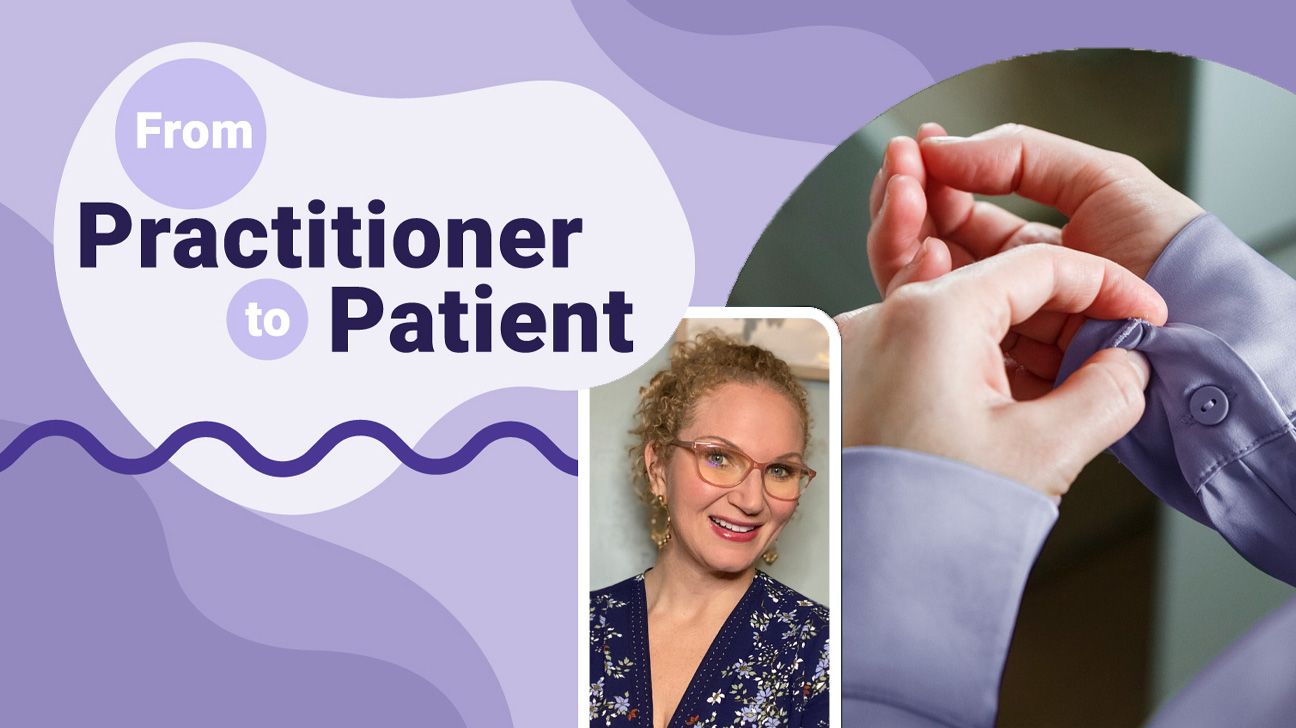10 Tips to Prepare for a Physical Exam
July 10, 2023
Content created for the Bezzy community and sponsored by our partners. Learn More

Collage design by Alexis Lira; photograph provided by Stefanie Remson; image by Getty Design
Welcome to From Practitioner to Patient, a column by Stefanie Remson about living with arthritis. Stefanie is both a nurse practitioner and a patient living with RA. She’s here to share what she’s learned from her own experiences as a patient and to demystify the medical side of navigating arthritis through her knowledge as a nurse practitioner.
Welcome back! You may feel nervous or excited about your upcoming physical exam. Whatever your feelings, I hope these tips will help you get the most out of your appointment.
A physical exam is a routine test conducted by a healthcare professional. It’s an essential part of how they can diagnose and manage your rheumatoid arthritis (RA). To read more about the physical exam for RA, check out this article.
In addition to the hands-on physical exam, a lot of crucial health information is exchanged and updated during the same office visit. So, it can be hard to know what is needed.
How can you optimize this type of office visit?
Here are my top 10 tips, from a nurse practitioner living with RA, to prepare you for your next physical exam.


1. Be prepared to have your vital signs checked
This typically includes height, weight, blood pressure, heart rate, and temperature. Each healthcare professional is different, and yours may want more or less data. The medical assistant or nurse may need access to your upper arm, forehead, and possibly under your tongue to obtain these readings.
Be prepared to remove enough clothing to expose these parts of your body. When it’s colder outside, a front zip jacket or sweater makes it easier to access your arm rather than something that goes over your head.
Try to avoid gum, candy, or mints in your mouth during the appointment. Avoid foods and mints that discolor your mouth before your appointment, too.
2. Drink plenty of water
Drinking water has many benefits, but it will also improve your skin elasticity, making it easier to examine you. Being dehydrated can cause your heart to beat fast or irregularly, your blood pressure to be low, and your mouth and eyes to be exceptionally dry.
3. Consider skipping breakfast
We all know the importance of eating a balanced breakfast, but in this case it may benefit you to show up in a fasted state (not having had anything to eat or drink in the past 8 hours.) This way, if your medical team wants to draw labs that require a fasted state, you’re ready to go!
This might not always be possible. But to make it easier, try booking your physical for first thing in the morning.
4. Avoid caffeine before your appointment
Consuming several cups of coffee or energy drinks before your appointment can increase your heart rate and raise your blood pressure higher than usual. You may even develop hand tremors (involuntary shaking) or have abnormal pupil responses (the black circle in the center of your eye that gets bigger or smaller based on light exposure) when you’re examined.
5. Bring a list of your medications with you
This list should include all prescriptions and over-the-counter (OTC) medications. Be sure to list the name of the medication, its strength (i.e., milligrams, one tab), the frequency (how often you take it), and how you take it (by mouth, intravenous, cream patch, etc.)
If you don’t know all of these details, take photos of your medication bottles with your phone. You can also ask your pharmacy to print you a list of everything they have filled for you in the past 12-24 months.
6. Bring any recent medical results and imaging
Bring the results if you’ve had testing, imaging (X-ray, CT, MRI), or lab work in the past 6-12 months before your appointment.
7. A more detailed health record can help, too
If you can, I always recommend creating a personalized health record (PHR), and you can learn more about that here. In particular, vaccine records have become increasingly vital. So, if you can’t complete a PHR, use this information from the Centers for Disease Control and Prevention (CDC) about maintaining your vaccine records. Here’s a good cheat sheet, too.
8. Be prepared to show your hands and feet
This is part of the physical exam for people living with RA and may play an essential role in your medical plan of care. Counting how many joints are affected, how severe your swelling and pain are, and if there is obvious deformity may change the types of medications and dosages to treat your condition.
9. Be prepared to show any areas of concern
If you have a specific issue you want to bring up, be prepared for this body part to be examined. For example, if you have new knee pain, be prepared to show your knee. Make sure to plan your wardrobe for that day around this, and opt for something that will allow easy access to the area.
10. Plan for a potential Telehealth appointment
If your appointment with your healthcare professional is via video call or Telehealth, be ready with a reliable internet connection, adequate lighting, and a private space.
You may need to show a specific body part on the camera, so be prepared to move slowly, provide extra lighting, and show different angles. You may even take photos before the appointment and share them if that’s an option.
Consider using headphones with noise cancellation when possible to help keep the conversation private.
Medically reviewed on July 10, 2023
1 Source


Like the story? React, bookmark, or share below:
Have thoughts or suggestions about this article? Email us at article-feedback@bezzy.com.
About the author